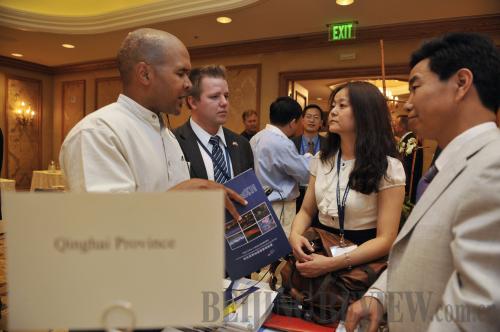|
 |
|
SWAPPING IDEAS: Attendees discuss economy, culture and education during the first U.S.-China Governors Forum in Salt Lake City, State of Utah on July 14, 2011 (ZHANG JUN) |
"Extended learning time, a deep connection to the arts, and a strong student support system have yielded positive results at Orchard Garden School in a short time," said McLaughlin, adding that both schools visited by the delegates "clearly demonstrate that a focused vision on student success can be achieved by a caring and dedicated staff."
Provincial leaders in China also described their efforts to turnaround weak or underachieving schools at the Forum. Shanghai, for example, is trying a number of approaches including asking the principals of high-performing schools to also manage a low-performing school and creating clusters of high- and lower-performing schools where teams of experienced teachers are transferred into the weaker schools to help improve the quality of teaching and learning, writes McLaughlin.
Deb Delisle, assistant secretary for Elementary and Secondary Education in the U.S. Department of Education, says Federal legislation has been targeted to identify and overcome discrepancies between high-performing and low-performing schools. During the George W. Bush administration, this took the form of No Child Left Behind. The regulations have now been transformed into the Elementary and Secondary Education Act (ESEA), enabling states to focus resources on the chronically lowest five percent of schools in each state.
Promoting education exchanges
Sherrill Parris, deputy state superintendent of education for the Alabama Department of Education, said she attended the forum in part because her state is looking to start educational exchanges with China.
The benefits of educational exchanges are "well known," writes Jeff Wang, Associate Director of Education and Chinese Language Initiatives Asia Society in New York. Students who study abroad report a transformative experience, and have a "vital" cross-cultural experience in a new era of globalization.
There is also increasing recognition of the benefits of international benchmarking as a tool for education policymaking, Wang writes.
"Nowhere is this imperative for engagement more important than between the United States and China. As China's influence in the world economy and politics grows, the need to increase understanding between the people of the United States and the people of China grows as well. International partnerships and exchanges in education play a key role in the U.S.-China relationship, providing the context and underpinning for dialogue and negotiation on a wide range of economic, political and social issues," he added. "Having more leaders in China in a wide range of fields who have studied in the United States, and more Americans in leadership positions who speak Chinese and have direct knowledge of the country and its institutions is crucial."
In 2010, then Secretary of State Hillary Clinton officially launched the 100,000 Strong Initiative, an effort to increase the numbers and diversify the composition of American students studying in China. The initiative was first mentioned by President Barack Obama during an official visit to China in 2009 and was officially launched by Secretary Clinton during the First High-level Consultation on People-to-People Exchange, which she and State Councilor Liu Yandong co-chaired in Beijing in May 2010. The U.S. Department of Education has a formal working agreement with the Chinese Ministry of Education, which has included joint projects on language learning, math education and vocational education.
China , as well, has strongly supported the expansion of educational partnerships. In 2012, China provided 13,500 scholarships for its students to study overseas, including over 6,000 for graduate students. Since 1978, when Deng Xiaoping began to send students abroad in large numbers as part of his modernization effort, nearly 2.64 million Chinese students have studied outside of China according to the Ministry of Education. Today, China is the largest supplier of students to universities in the United States with roughly 194,000 Chinese students on American campuses in 2011-12, according to data from the Institute of International Education.
Li Ji Helen, author of "The Stories of an Only-Child's Mom from China to America" and delegate to the Boston forum, said academic study is secondary to the cultural experiences achieved in exchanges for students and educators. One key difference between the two countries is the teacher-centered methods of China vs. the student-centered educational model of the United States. Many students have trouble adjusting to a foreign lifestyle, and need support once they arrive.
"The reality totally changes when they come here," Li said.
Blueprint for the future
While educational exchanges and sharing best practices play key roles in shaping the next generation of globalized students, it is clear that a broad organized effort is needed.
"We need to have a sustainable model if real progress is to be made. Many one-off local exchanges are springing up, but given the scale and the importance of the U.S.-China education collaboration, we need an infrastructure that will take us from a model of somewhat unconnected annual meetings to an adequately-supported, goal-driven and permanent state and provincial and national-level organization," said forum participant Mark Oettinger, General Counsel of the Vermont Department of Education, adding that there are successful models that have developed over the past two decades in the legal and judicial context between the United States and Russia.
Interest in Sino-American exchanges is at an all-time high, as China's rapid economic development and rising global influence will "define the 21st century, as U.S. ties to Europe did in the 20th century," said U.S. private equity tycoon Stephen A. Schwarzman, founder of Blackstone Group. Schwarzman announced plans to raise $300 million, including a $100 million personal gift, to establish a Rhodes Scholarship-type program with Tsinghua University. The endowment will allow 200 students a year from around the world to take part in a one-year master's program at Tsinghua.
"China is no longer an elective course, it's a core curriculum," he said in Beijing.
The author is a contributing writer to Beijing Review, with reporting by Huang Wei, from Boston, Massachusetts. | 